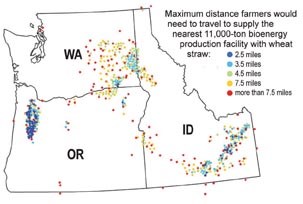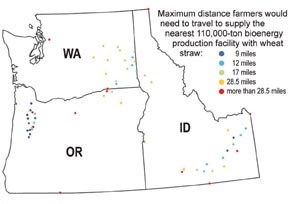Bioenergy Options in the Pacific Northwest
Clutching at 6 Million Tons of Straw
Pacific Northwest farmerscan make a good profit on their wheat, barley, oats, and grass-seed crops. But when they sell the leftover straw for livestock feed and bedding, they barely break even. Converting that straw to bioenergy could result in added value all the way around—more money for farmers and more renewable energy for consumers.
Now, Agricultural Research Service agronomist George Mueller-Warrant, plant physiologist Gary Banowetz, and hydrologist Jerry Whittaker have figured out the best locations in the Pacific Northwest to build facilities to produce bioenergy from straw. Their calculations could help producers and biorefiners minimize straw-transaction costs and maximize returns as bioenergy production ramps up.
“Straw is bulky and doesn’t have nearly the energy content that corn does. So the model for shipping corn grain to a Midwest ethanol bioenergy plant isn’t really applicable for much of the Pacific Northwest, where straw density per acre is small,” says Banowetz, who works with Mueller-Warrant and Whittaker at the ARS Forage Seed and Cereal Research Unit in Corvallis, Oregon. “And since rainfall patterns are a lot more variable in the Pacific Northwest, our straw yields are variable as well. Since we don’t have a uniform biomass yield across the region, it makes sense that different-scale conversion facilities are needed that account for the available straw that can be economically supplied to them from local sources.”
“So we needed to figure out where the straw was and where the straw wasn’t,” Mueller-Warrant says. “Once we knew that, we could begin developing models for locating the conversion facilities.”
Taking Inventory
The scientists used a combination of satellite imagery, data from the USDA National Agricultural Statistics Service and the National Land Cover Database, and other information to produce county-by-county straw yields for 2005, 2006, and 2007. After excluding straw residues left on fields to protect the soil from erosion and to help maintain soil quality, they determined that the average annual regional straw yield was around 6.2 million tons—enough straw to produce more than 430 million gallons of biofuel.
Then the scientists revised a statistical approach used by community planners and business developers to determine the best locations for stores, hospitals, police stations, and other facilities. They used the revised methodology to calculate how many total biofuel facilities could be supplied by the average annual straw yield—and where to locate the plants so that the costs of transporting low-density straw could be minimized.
In their studies, they looked at facilities that had three different scales of annual production: Small-scale facilities could handle 1,100 tons of straw, medium-sized facilities could handle 11,000 tons of straw, and large-scale facilities could handle 110,000 tons of straw. Relative to the corn-to-ethanol plants operating in the Midwest, all three sizes represent small-scale facilities.
The model for the small-scale plant was a syngas-powered electrical generator system suitable for a farm-sized facility, a model currently being tested by the Corvallis scientists on a farm in Spokane, Washington. The large-plant model was similar to an Oregon biofuel facility in development for the western part of the state. The model for the medium facility was for either a large-scale syngas production facility or a series of distributed bio-oil production sites with railway access for shipping bio-oil to large, more centrally located refineries that could be supplied with straw from several farms.
Conveniently Located in a Field Near You
Results indicated that the straw in the Pacific Northwest available for producing bioenergy could be allocated to 6,200 small facilities, 660 medium facilities, or 64 large facilities (see maps). The smallest facility could provide enough electricity to serve the needs of 55 people, based on average annual electricity usage in the United States. While this electricity could be returned to the electrical distribution grid for general use, it is most likely that electricity produced from the small facilities would be used on farms to power irrigation pumps, dairy operations, or seed- and grain-cleaning mills.
|
An ARS team ran a series of computer models that identified the best locations for building bioenergy plants based on how closely the plants could be located to wheat straw feedstocks needed for ethanol production. The facilities are color coded on each map to indicate the maximum distance the straw would need to be transported to supply the nearest facility. Reducing transport costs is key to farmers’ making a profit in this enterprise. |
 |
 |
 |
More than half the plants of all three sizes had enough straw available within a reasonable travel radius. For example, in regions like eastern Washington, where straw production averages around 2 tons per acre, producers would have to travel a median distance of 1.4 miles to supply the small-scale plants. In the Willamette Valley of western Oregon, where annual straw production is about 4 tons per acre, a median travel distance of under 1 mile would supply the same-sized plants. Across the region, producers supplying the largest plants would have to travel a median distance of 13 miles.
The variability in straw distribution would probably mean that only 80 to 90 percent of the total available straw could be used for bioenergy production. While the small plants were distributed more evenly across the Pacific Northwest, the straw supply for these facilities was more variable from year to year. “Farmers are used to variability,” Mueller-Warrant observes wryly.
“That’s part of the larger risk analysis that will be involved in siting these plants,” Banowetz adds. “Even though smaller facilities might have more variability in their biofeedstock supply, they would also require less start-up capital. And an on-farm energy system could help insulate farmers who use a lot of electricity, like dairy farmers or farmers who irrigate, from energy price increases.”
“When we evaluate our results, we also need to consider the impact of evolving energy-production technologies,” Mueller-Warrant says. “We don’t know what will be available 5 to 10 years from now and what will be a factor in the cost-effectiveness of these sites. Maybe the winner will end up being a farm-scale system—or maybe it will be a large-scale bio-oil or bio-gas plant.”
Says Banowetz, “Idaho, Washington, and Oregon all have state mandates to increase their energy production from renewable sources. For instance, by 2020, 20 percent of Oregon’s energy will need to be produced using renewable resources—and Oregon doesn’t classify hydropower as a renewable source. So these mandates are driving a lot of interest in our work and our findings.”—By Ann Perry, Agricultural Research Service Information Staff.
This research supports the USDA priority of developing new sources of bioenergy and is part of Bioenergy (#213) and Agricultural System Competitiveness and Sustainability (#216), two ARS national programs described at www.nps.ars.usda.gov.
To reach the scientists mentioned in this story, contact Ann Perry, USDA-ARS Information Staff, 5601 Sunnyside Ave., Beltsville, MD 20705-5129; (301) 504-1628.
"Bioenergy Options in the Pacific Northwest: Clutching at 6 Million Tons of Straw" was published in the February 2011 issue of Agricultural Research magazine.






